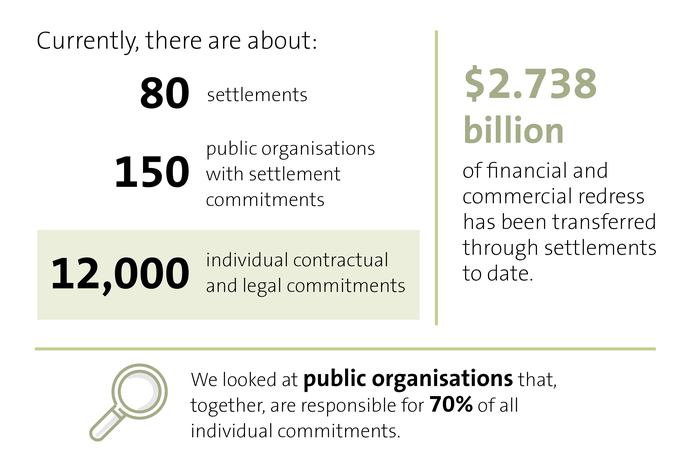How public organisations are fulfilling Treaty settlements

Summary of our report
Te Tiriti o Waitangi/the Treaty of Waitangi is an agreement that the British Crown and rangatira reached in 1840. It set out terms for establishing British government in New Zealand.
Since te Tiriti was signed, the Crown has not met its obligations. In modern times, this has led to claims against the Crown through the Waitangi Tribunal. Since 1989, successive Governments have sought to resolve these claims through settlements with iwi and hapū.
Today, about 150 public organisations have about 12,000 individual contractual and legal commitments under about 80 settlements with about 70 groups. To date, $2.738 billion of financial and commercial redress has been transferred through settlements.
Many public organisations do not properly plan how they will meet their commitments, nor do they prioritise sufficient resources to do so. Many do not have effective processes for monitoring whether they are meeting their commitments. Some public organisations also have limited access to support and advice.
Public organisations need to make a significant shift in the way they manage settlement commitments to realise the potential and purpose that Cabinet and Parliament stipulated in deeds of settlement and settlement Acts.
The public sector needs to understand that settlements are the basis for long-term relationships with iwi and hapū, and that it needs to manage them accordingly.
What's in this report
Why we looked at Treaty settlement commitments
We wanted to provide assurance about whether public organisations were well positioned to meet their legal and contractual commitments to fulfil settlements as intended. We also wanted to provide assurance about how well they understood any risks associated with meeting their commitments.
Public sector arrangements for fulfilling settlements
We outline oversight and monitoring arrangements set out in the He Korowai Whakamana framework. We discuss how the number of settlements has increased and how the nature of redress has evolved over time.
Understanding settlement responsibilities and fulfilling them
We wanted to assess how well these public organisations understand the settlements and settlement commitments that they are responsible for and how well public organisations were set up to fulfil their settlement responsibilities.
Advice and support for public organisations
Over time, including before He Korowai Whakamana was introduced, public organisations have had access to a range of advice and guidance about providing redress (and resolving any associated issues). We wanted to assess how well this advice and guidance supported public organisations to provide redress as intended.
Assurance, transparency, and accountability
We wanted to understand how well public sector arrangements provide assurance, transparency, and accountability to Parliament, Ministers, Crown entity governors, councillors, post-settlement governance entities, iwi and hapū, and the public.
Our recommendations
We have made nine recommendations aimed at strengthening the settlement system's leadership and improving its integrity. They have been organised into two groups – recommendations directed at all public organisations, and recommendations directed at the public organisations we specifically looked at for this work.
